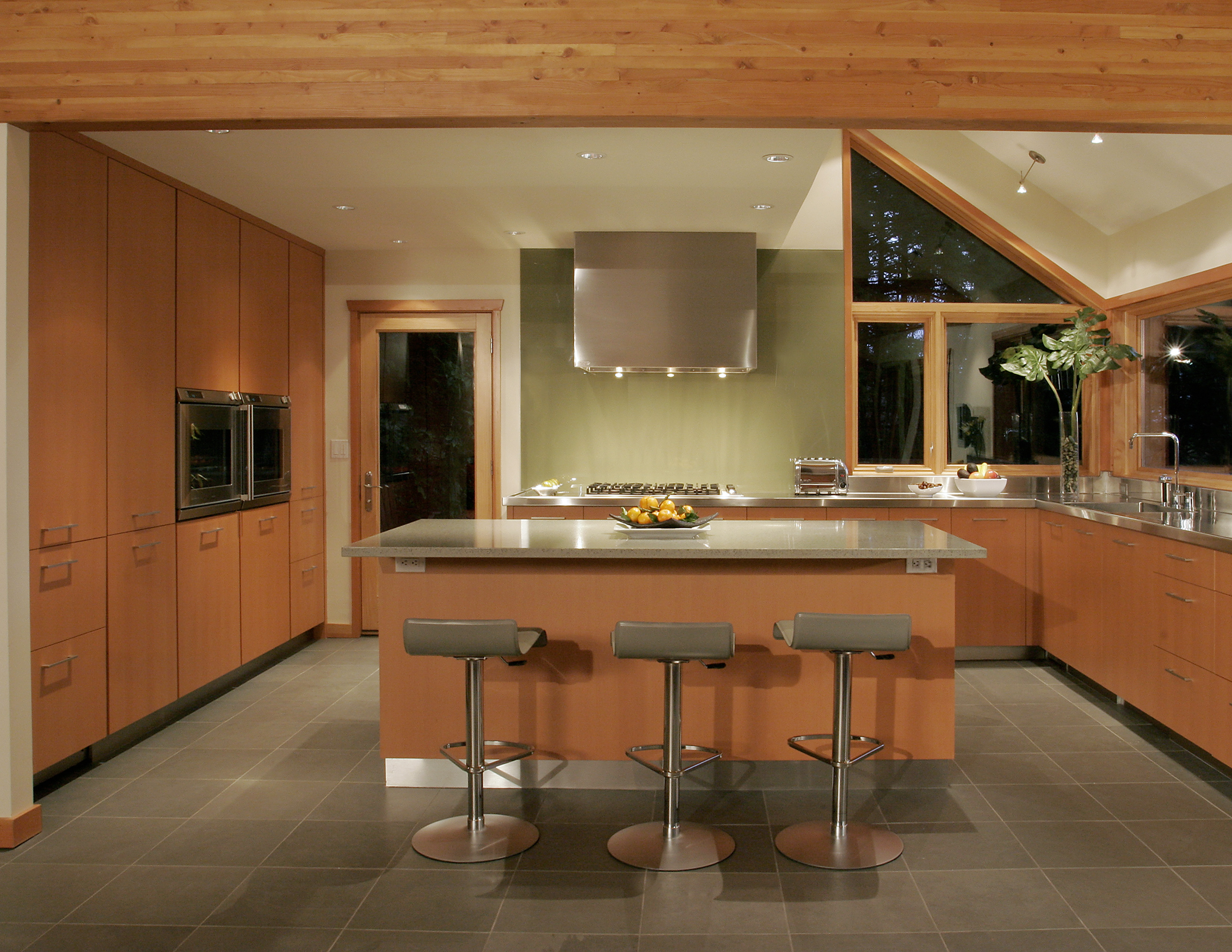
Custom Homes
|Interiors
14 Ways to Bring the Outdoors In with Biophilic Interior Design
Now that we’ve spent more than a year of our lives mostly confined in our homes, and now that Spring has officially sprung, our typical Pacific Northwest enthusiasm for the outdoors is on a whole new level. Needless to say, using nature as inspiration for your home’s interior, otherwise known as Biophilic Design, is really having a moment.
More than plants and earth tones
When you decide that you’d like to bring the outdoors inside, you might be wondering what more you can do than collect houseplants or decorate with earth tones and organic materials—and there’s a lot more.
The concept of Biophilic Design is rooted in our innate attraction to nature and suggests that making that connection in our homes can promote physical and mental wellbeing. The architects of this concept (pun intended) found that nature-inspired interior design has the power to enrich urban environments by creating multi-sensorial, tranquility-inducing experiences in our human-built spaces.
“Biophilic Design is an innovative way of designing the places where we live, work, and learn. We need nature in a deep and fundamental fashion, but we have often designed our cities and suburbs in ways that both degrade the environment and alienate us from nature. The recent trend in green architecture has decreased the environmental impact of the built environment, but it has accomplished little in the way of reconnecting us to the natural world, the missing piece in the puzzle of sustainable development.” – Stephen Kellert
Here are 14 ways to incorporate Biophilic Design in your home
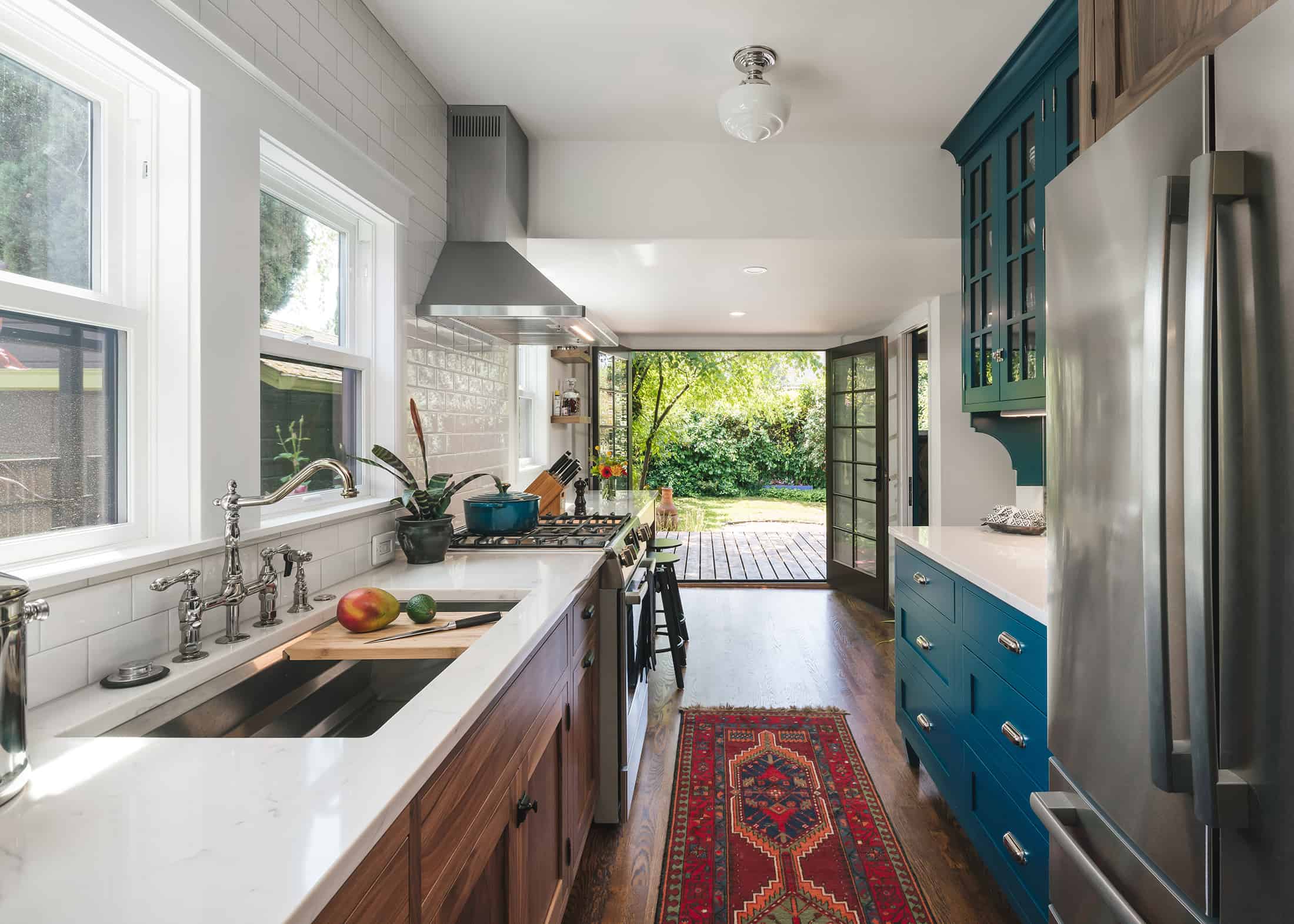
A kitchen in Portland’s Alberta Arts District incorporates Biophilic Design with multiple windows and an oversized doorway to the outdoors
There’s lots of overlap here, and that’s sort of the point. Biophilic design requires a network of physical objects—a complex interweaving of many elements that work together to create a common link with nature. Each of the following suggestions offer stress reduction, improvements in cognitive performance, and a boost to your mood or emotions.
Nature in the space
1. A visual connection or view of nature
There’s no denying that an expansive view of the surrounding environment is instantly calming. If you’re lucky enough to have a home with a great view, you’re going to want plenty of large windows through which to gaze upon it (or surveil it, according to suggestion #11.). But if you don’t, there are still things you can do to create a visual connection with nature. Skylights would be an excellent choice and also aid in suggestion #6 below. Photographs or other pieces of art depicting the natural world will give you a visual connection as well. This is also where houseplants come into play.
2. Connection through other senses (sounds, smells, textures)
The sound of trickling water has been known to soothe us, as have the scents of certain essential oils. Try placing a water feature in your home or garden, and diffusing oils like lavender, ylang ylang and sweet orange. When it comes to texture, the world is your oyster; wood and wicker furniture, wool and jute rugs, a zen sand garden, or try a moss bath mat!
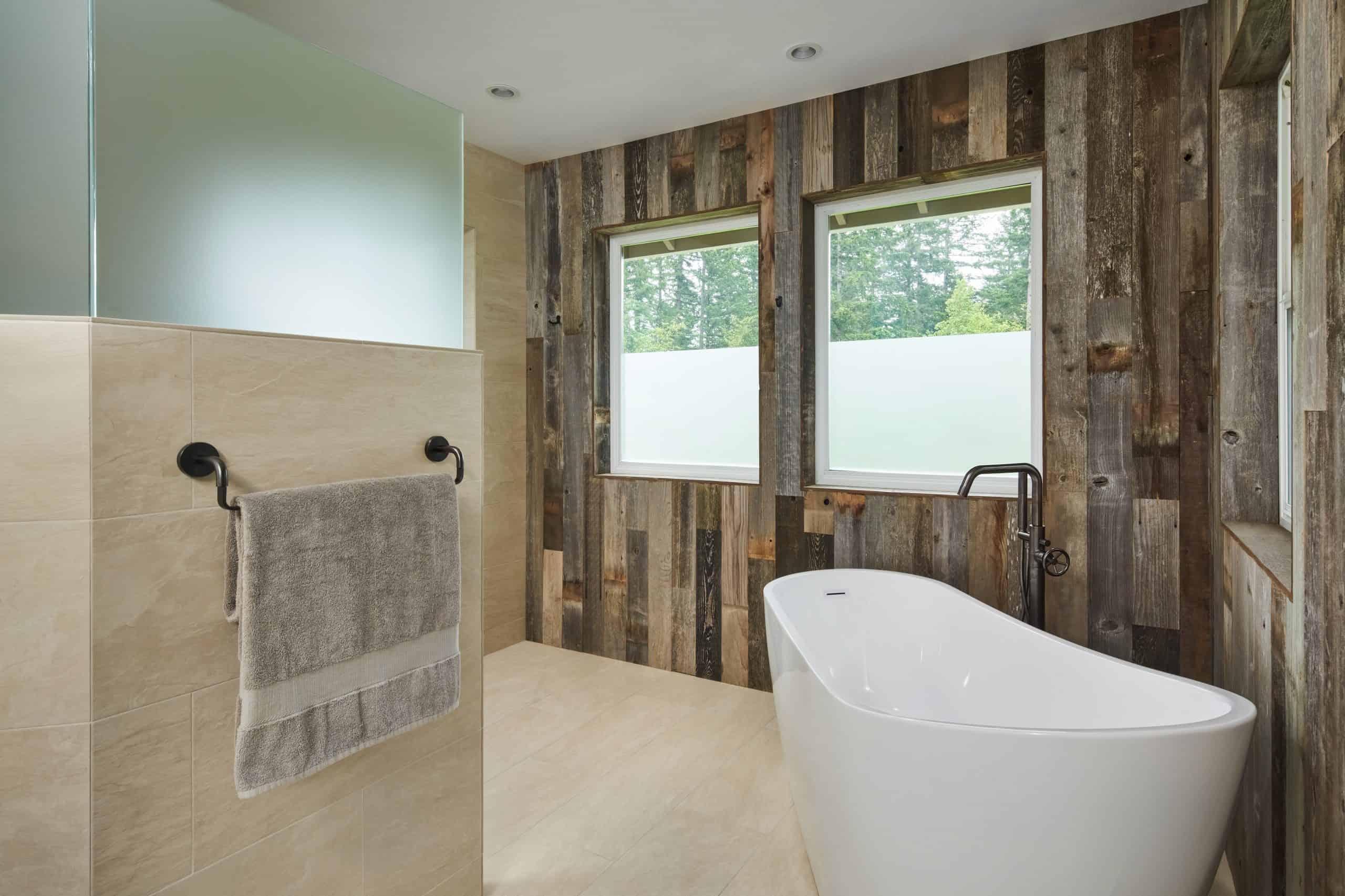
A newly remodeled primary bathroom in Lewisville, Wash. features rustic wood wall cladding inspired by nature.
3. Non-rhythmic sensory stimuli
Okay this one sounds complicated, so let us clarify: Non-rhythmic basically just means random, and in nature there are a million things that move or make sounds in random ways. The way butterflies flutter or the way leaves rustle in the wind, for example. Studies show that we process the movement of living things in a different part of our brains than where we process the movement of mechanical objects. When we are immersed in nature, we continually experience non-rhythmic stimuli like birds chirping or the faint smell of eucalyptus in the air, which will capture our attention and offer recurring physiological benefits. You can incorporate non-rhythmic sensory stimuli in your home by keeping a window open to let the breeze flow through your drapes (more on that next) or playing nature sounds.
4. Thermal and airflow variability
We all know how uncomfortable it can be in a space with stagnant, over-processed air. In fact, research has shown a direct correlation between poor air quality and a loss of productivity. We tend to prefer natural airflow and subtle changes in temperature and humidity, which lead to immediate comfort and improved concentration.
“Most people’s HVAC systems are not meeting the ASHRE ( American Society of Heating, Refrigerating and Air-Conditioning Engineers) recommendation for the air in our homes to be fully exchanged 3 or 4 times daily for our optimal health. Cleaning our air ducts, using humidity sensors, and adding ventilations to areas like walk-in closets can really improve the health and quality of indoor air.” says Therese DuBravac, Design Consultant for Neil Kelly in Portland since 2002.
While it’s important to be able to control the temperature and humidity in your home, we can still enjoy natural variability through some intentional methods. It’s amazing how uplifting it can be to open your windows when the outdoor temperature is just right. You could even create an indoor/outdoor space – maybe a covered patio or balcony – that provides the comforts of indoor seating as well as the breezes and views of nature. Even just placing a comfy chair near a sunny window can help you enjoy the slight temperature changes when the sun breaks through on a partly cloudy day.
5. Presence of water
While we’ve already mentioned it a time or two, it can’t be stressed enough how instantly calming and natural it is to be in the presence of water. Its sensory impact can be visual, auditory, or experienced through touch. You might consider adorning a space in your home with a waterfall sculpture or even an aquarium.
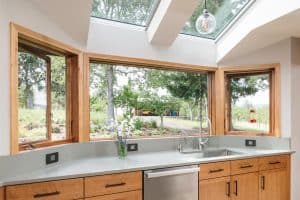
A kitchen designed by Neil Kelly featuring large windows and skylights above the sink.
6. Dynamic and diffuse light
There’s no place in nature where the light stays the same night and day. To connect with nature, we need changes in light intensity and color. Natural light is a hot topic in interior design, and for very good reasons: it wards off seasonal depression, improves your sleep and circadian rhythm, and boosts vitamin D. By maximizing natural light in your home with windows and skylights, you’ll connect to nature through direct sunlight, seasonal light, moonlight, dappled light, and moving shadows.
Related: Enhance Your Home with Lighting
7. Connection with natural systems
This pattern overlaps with many of the others on this list. For the most part, it’s a visual one, but can also allow you to get your hands dirty a little bit. Natural systems are things like weather changes, animal behavior, and plant growth. You can see leaves change color in the fall and watch the birds and squirrels do their thing from a comfy window seat. To take it a step further, try your hand at an indoor herb garden. Photosynthesis is a natural system you can get involved in with considerable reward. Not only will you grow your own food, you’ll also improve your mental engagement and feelings of accomplishment and well-being.
“We have an innate attraction to the natural world yet find ourselves increasingly separate from nature. Bringing elements of nature indoors can be surprisingly comforting and important to our health and well-being,” says Karen Richmond, Neil Kelly Portland Design Consultant in the remodeling industry for more than 40 years. “In a kitchen in Vancouver, Wash., we built a custom planter behind the kitchen sink. The window was lower than the counter height, and rather than make a change to the exterior with brick, we pulled the cabinets forward and had a copper tray made for herbs.”
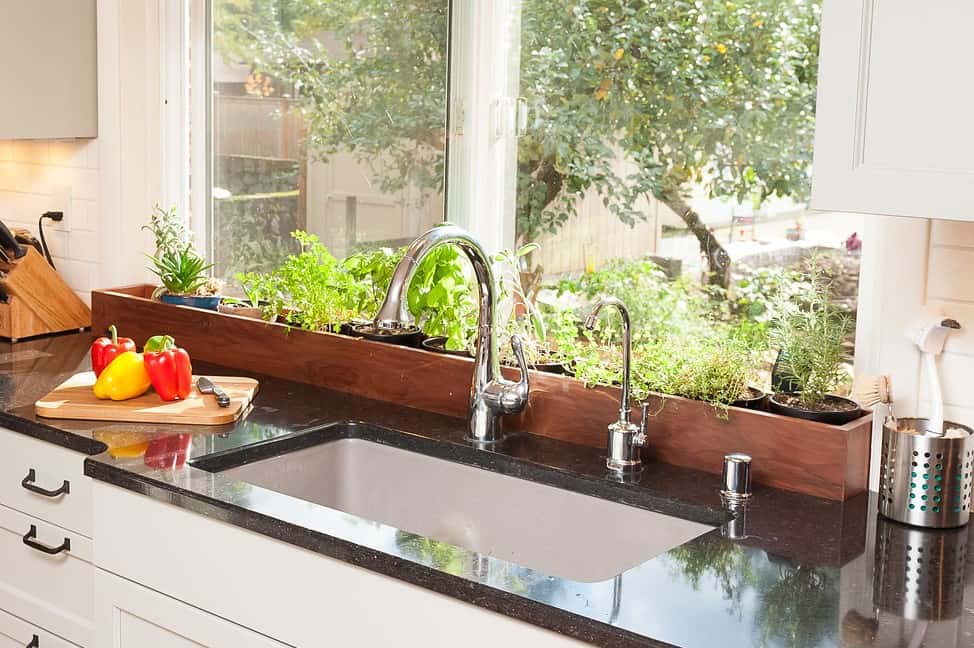
Mimicking Nature
8. Biomorphic forms and patterns
Through architecture and/or decoration, your home can include symbolic references to shapes and details that persist in nature, either literally or in a more abstract way. Imagine large columns that look like trees, clustered light fixtures that look like clouds, or maybe a railing with twisting metal that mimics a vine. Your home could even have a dramatic roofline with numerous peaks to remind you of the mountains.
9. Material connection with nature
When reflecting nature in your home design, you’ll definitely want to include natural materials. Even better, you might choose those that nod to your local ecology, which will create a distinct sense of place. When selecting the key elements of your home’s design and decor—like flooring, cabinets, countertops, fixtures, and color—give special consideration to wood, natural stone, leather, grasses, and other materials that reflect time and use. Research has shown that rooms with 45% wood can decrease a person’s blood pressure and improve creative performance.
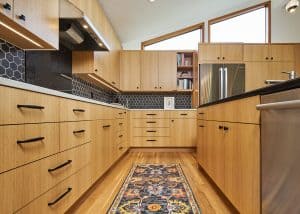
Resting in the hills above the Willamette River, this home’s kitchen cabinets are constructed with beautiful quarter-sawn white oak.
10. Complexity and order
As free flowing as nature may seem, geometry is at play all over the place. There are two very common geometries, and the first is called the Fibonacci Sequence. The Fibonacci Sequence describes the swirl pattern found in hurricanes, snail shells, and the human ear (among many other things). Consider a curved or spiral staircase to bring this nature-inspired shape into your home. The other bit of geometry commonly found in nature is called a fractal pattern. This pattern presents itself similarly up close as it does from far away by repeating a similar shape or detail at different scales. Fern branches, for example, have a familiar shape and when you look up close you’ll see that each small leaf has the same shape of each of its branches. Replicating these geometries in architecture and design (though often not literally) can decrease anxiety and invoke positive physiological responses.
Nature of the space
11. Prospect
A theory in Biophilic Design suggests that humans evolved from the African Savannah, and so we naturally gravitate toward habitats with vantage points that give us an opportunity for surveillance. Prospecting areas are open, bright, and typically elevated to provide an unimpeded view over a distance. This would include balconies, staircase landings, and open floor plans which can increase our sense of safety, relaxation, and attentiveness.
12. Refuge
In a wide open space, lots of us like to withdrawal to a somewhat secluded place where we feel protected, but can still feel connected to the larger space. Areas like this are usually enclosed to one’s back and overhead, thereby reducing stress and improving rest. You could create this type of space in your home just by adding adjustable blinds or seating with high backs. Other examples of refuge might be a private office, breakfast nook, or gazebo.
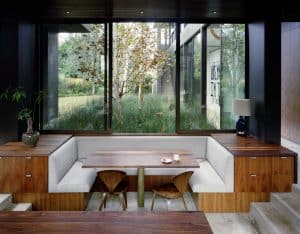
The Vienna Way residence of architect Ron Radzinier. Photo by Joe Fletcher / LA Times.
13. Mystery
According to Biophilic Design, adding a little bit of mystery to your home design will entice you and your guests to move through the space for the promise of more information. In general, mystery is presented when at least one, but preferably two edges of a focal object are obscured to the viewer. This might take form as a winding pathway or windows that only partially reveal what’s on the other side. Sound can be mysterious, too, if you were to play music that comes from hidden speakers.
- 14. Risk
- While most of us prefer to feel the upmost safety in our homes, introducing risk (along with reliable safeguards to prevent actual peril) can increase our dopamine levels leading to heightened motivation, memory, and problem-solving abilities. These risks might be falling, getting wet, or losing control. Design features that play upon these risks include balconies or catwalks with transparent railings or floor planes; pathways that pass under, over or through water; and architectural cantilevers or objects that appear to defy gravity.
Inspired? Learn more about our Design/Build Remodeling services in Portland, Seattle, Bend and Eugene.